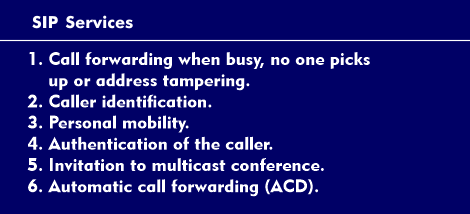session initiation protocol (IP) (SIP)
The Session Initiation Protocol(SIP) is a signaling protocol from 1999 that was standardized by the Internet Engineering Task Force( IETF) for sessions with two or more participants. Sessions can be established, modified, and terminated using the SIP protocol. The text-oriented SIP protocol, which is based on HTTP, is used to transmit real-time data over packet-switched networks. It is functionally similar to the H.323 protocol and specifies the connection modalities for interactive communication services including Internet telephony( VoIP) over IP networks.
The Session Initiation Protocol has a simpler structure than H.323, is scalable using a transaction model rather than a connection model, and can use Secure Socket Layer( SSL) and Transport Layer Security( TLS) for security. The SIP protocol complements other communication protocols such as the Realtime Transport Protocol( RTP) and the Realtime Streaming Protocol( RTSP). To establish a subscriber connection, the SIP protocol does not use the subscriber's IP address, because this can change, but instead uses its own SIP address, which is similar in structure to an e-mail address.
SIP information can be transported using the TCP protocol or the UDP protocol. The SIP protocol has an open Internet-based structure and enables CLASS(Custom Local Area Signalling Service) features such as the transmission of the caller's identity or call forwarding in IP-based networks. Furthermore, call hold, music on hold, call transfer with consultation, call forwarding, call pickup, initiation of conference calls, call repetition and much more. Due to the open structure, new features can be implemented faster and easier than with the conventional telephone network( PSTN). The SIP protocol is responsible for call signaling, user location and registration. It is more secure than H.323 because it uses only two defined TCP ports, while H.323 requires the full range of dynamic ports. Quality of service, directory access, and session procedures are handled by other protocols.
The SIP protocol was originally designed for device-to-device transmission rather than as a network protocol, but it is increasingly becoming a Web-based user management service as a result of developments.
The SIP protocol originates from the IETF and is described in RFC 3261.

